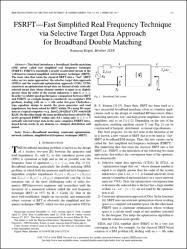FSRFT - Fast simplified real frequency technique via selective target data approach for broadband double matching
Citation
Köprü, R. (2017). FSRFT-fast simplified real frequency technique via selective target data approach for broadband double matching. IEEE Transactions on Circuits and Systems II: Express Briefs, 64(2), 141-145. doi:10.1109/TCSII.2016.2557238Abstract
This brief introduces a broadband double-matching (DM) solver called fast simplified real frequency technique (FSRFT). FSRFT is essentially a greatly accelerated variant of the well-known classical simplified real frequency technique (SRFT). The basic idea that turns the classical SRFT into a 'fast' SRFT relies on two main approaches: the selective target data approach (STDA) and the constraint optimization approach (COA). STDA constructs an optimization target data set formed of only critically selected target data whose element number is equal to or slightly greater than the order of the system unknowns n plus 1, {n}+1. In order to exhibit speed performance comparison between SRFT and FSRFT, an example design is considered. An exemplary DM problem, dealing with an {n}=6th order low-pass Chebyshev-type equalizer design to match the given generator and load impedances, has been solved by SRFT within 29 s using 90 target data in a typical computer - e.g., Intel 2.20-GHz i7 CPU with 8-GB RAM. On the other hand, the same problem has been solved by the newly proposed FSRFT within only 0.6 s using only n+1=7 critically selected target data in the same computer. FSRFT introduced herein works in any domain, i.e., lumped, distributed, and mixed.
Source
IEEE Transactions On Circuits And Systems II-Express BriefsVolume
64Issue
2Related items
Showing items related by title, author, creator and subject.
-
A frequency transformation based real frequency design approach for dual-band matching
Aksen, Ahmet; Yıldız, Serkan; Yarman, Bekir Sıddık Binboğa (IEEE, 2017)This work describes a real frequency design approach for dual-band matching networks. The proposed design technique employs a direct low-pass to dual pass band frequency transformation in the scattering based real frequency ... -
Dual band matching network design via real frequency technique by mapping from a band pass prototype
Yıldız, Serkan; Aksen, Ahmet; Yarman, Bekir Sıddık Binboğa (IEEE, 2016)In this study, a new method of design for dual band matching network is presented. A transformer-less Band Pass (BP) prototype matching network is synthesized with well-known Simplified Real Frequency Technique (SRFT) via ... -
A numerical approach for the design of matching networks consisting of brune sections based on fujisawa constraints
Yıldız, Serkan; Aksen, Ahmet; Yarman, Bekir Sıddık Binboğa (IEEE, 2018)In this study, the realization problem of matching network consisting of Brune sections is investigated. In the synthesis of a general impedance function with finite transmission zeros, each transmission zero extraction ...


















